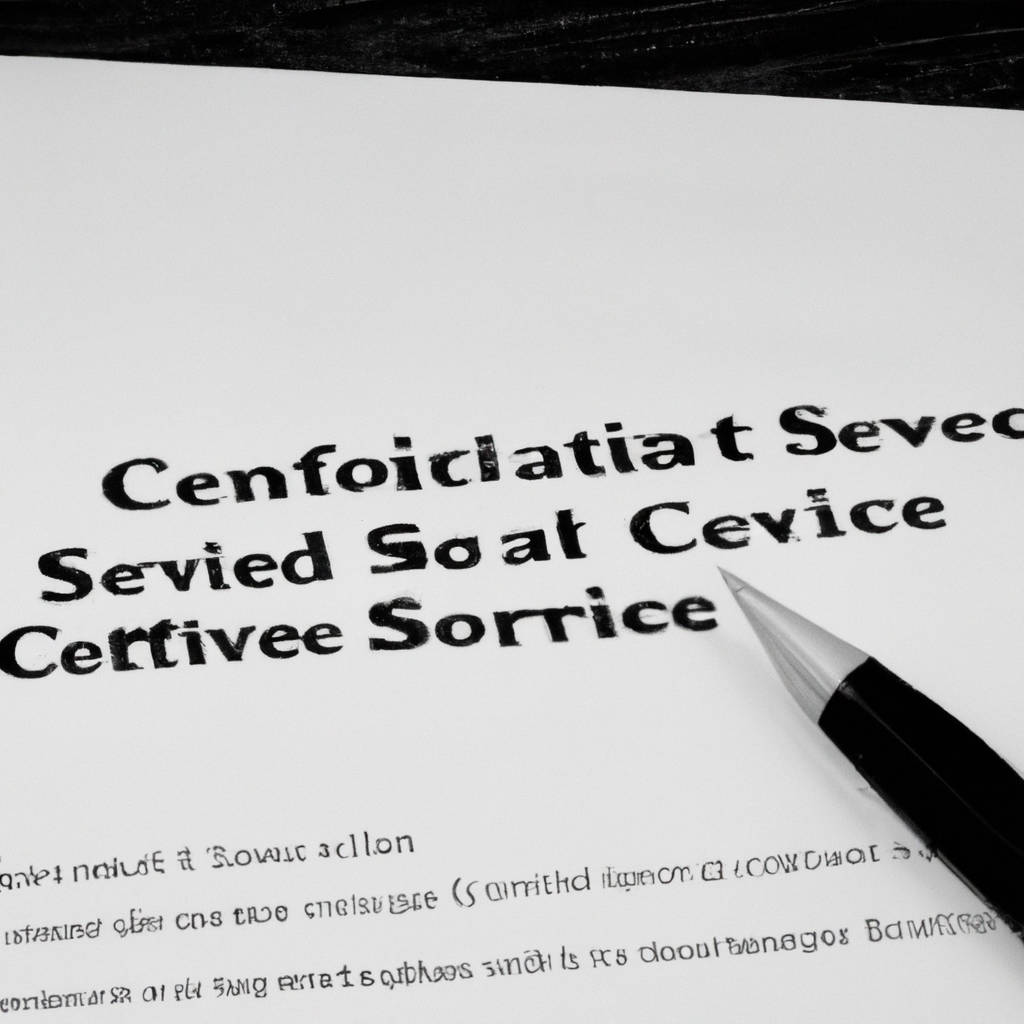Crafting an effective customer service cover letter begins with understanding the importance of this document. This is the initial communication that a potential employer will have with you, and it serves as an introduction to your application. The primary aim is to grab the reader’s attention and encourage them to further explore your resume. To achieve this, there are several crucial elements that must be included in your cover letter.
Firstly, it is essential to start with a compelling introduction that captures the essence of your professionalism and dedication to customer service. Highlight your most relevant experiences, skills, and achievements related to the customer service field. Tailoring your content to match the specific requirements of the job description can significantly increase your chances of securing an interview.
Secondly, the body of your cover letter should provide detailed examples of how you have demonstrated these skills and experiences in previous roles. Remember to be specific and use quantifiable achievements where possible. For instance, you could mention how you increased customer satisfaction ratings or reduced complaint resolution times in a previous customer service role.
Furthermore, expressing your passion for providing excellent customer service can enhance your cover letter’s effectiveness. This can be demonstrated by elaborating on how you have gone above and beyond to meet customer needs in the past, or how you have made an impact on a team or company through your customer service skills.
In addition to these content considerations, the layout, structure, and tone of your cover letter are also crucial. It should be concise, well-organized, and free of any grammatical errors or typos. Using a polite and professional tone is also vital in conveying your commitment to providing top-notch customer service.
Lastly, always remember to close your cover letter by thanking the reader for considering your application and expressing your interest in discussing your qualifications further. This not only shows your appreciation but also reinforces your enthusiasm for the role.
By incorporating these elements into your cover letter, you can craft a compelling narrative that effectively showcases your customer service skills and experiences. This will not only help you leave a positive and lasting impression on potential employers, but also increase your chances of landing a job in the customer service field.
In conclusion, an effective customer service cover letter is a strategic blend of tailored content, compelling examples, and professional presentation. It is a powerful tool that can differentiate you from other candidates and pave the way for a successful job application. So, take the time to craft a cover letter that truly reflects your qualifications, dedication, and passion for customer service.

Understanding the Significance of a Customer Service Cover Letter
A customer service cover letter is an essential tool for anyone aspiring to work in customer service roles. This document holds immense significance as it serves as the first impression to potential employers, showcasing your capabilities and experience in the field. It’s an opportunity to highlight your skills, experiences, and qualities that align with the job description and company values. A well-structured and written cover letter can set you apart from other candidates, emphasizing your passion for providing excellent customer service and your ability to handle challenging situations. It’s a chance for you to communicate how your unique background makes you the perfect fit for the role. Moreover, it allows the employer to gauge your written communication abilities, which are vital in customer-related roles. A compelling customer service cover letter can be the deciding factor in landing an interview or even securing the position. Therefore, it is crucial to invest time and effort in crafting a persuasive cover letter that effectively highlights your suitability for the role. Remember, it’s not merely a summary of your resume but a platform to tell a story about your professional journey and how it equips you for the customer service role you’re applying for. A captivating cover letter can make all the difference in your job search, underscoring the importance of understanding this significant document.
Examples of Customer Service Cover Letters
Customer service cover letters are essential tools when applying for a job in the customer service industry. Examples of these letters can provide a solid foundation for crafting an impressive job application. They are typically used to highlight a candidate’s relevant skills, experiences, and qualifications related to customer service. These letters should be tailored to the specific job description, focusing on how the applicant can meet the employer’s needs and contribute to the company’s success.
Examples of customer service cover letters often start with a formal introduction, addressing the hiring manager by name if possible. They then go on to outline the candidate’s professional background, emphasizing any past roles in customer service. The letter should include specific instances where the applicant demonstrated excellent problem-solving abilities, communication skills, and a commitment to providing top-notch customer service.
In these examples, the applicant might mention how they handled difficult customer situations, achieved high satisfaction ratings, or implemented new strategies to improve customer service. They may also discuss any relevant certifications or trainings they’ve completed. The goal is to convince the hiring manager that they are the right fit for the role, leveraging their skills and experiences to make a strong case.
In conclusion, these cover letter examples typically end by expressing enthusiasm for the opportunity to interview and contribute to the company. They also thank the hiring manager for their time and consideration. Overall, examples of customer service cover letters serve as a guide for candidates in showcasing their skills and experiences effectively, tailoring their applications to the specific job, and making a memorable impression on potential employers.

Example cover letter 1
An example cover letter is an essential tool that provides a comprehensive outline to job seekers, guiding them on how to craft their own cover letters efficiently. It serves as a model that demonstrates the right structure, tone, and content needed to create a compelling letter that can grab the attention of potential employers. A well-written example cover letter typically provides a header with the applicant’s contact information, followed by a polite greeting. The first paragraph introduces the applicant, the position they are applying for, and where they found the job listing. The main body highlights the applicant’s relevant skills, experiences, and achievements, linking them to the job description provided by the employer. The closing paragraph usually includes a call to action, expressing the applicant’s eagerness for an interview and gratitude for the opportunity. An example cover letter is meant to be adaptable, allowing job seekers to modify it to suit different positions and companies. It is an indispensable resource, enabling individuals to present themselves professionally and convincingly, thereby increasing their chances of landing an interview. Despite the rise of digital job applications, a well-tailored cover letter remains a crucial part of the job hunting process. It is a direct communication channel to the employer, offering a platform to not only showcase one’s qualifications but also their personality and motivation for the job. Therefore, an example cover letter is more than just a template; it is a strategic guide to making a strong first impression.
Example cover letter 2
An exemplary cover letter, such as Example Cover Letter 2, can be a pivotal tool in showcasing your skills, experiences, and potential value to a prospective employer. This cover letter, crafted with precision and tailored to the job description, sets a compelling tone. It opens with a captivating introduction, instantly grabbing the reader’s interest by briefly highlighting the writer’s relevant experience and passion for the job. The body of the letter then delves into more detail, showcasing relevant skills and specific examples of achievements, all while demonstrating a thorough understanding of the company’s needs. The writer deftly aligns their abilities and accomplishments with the organization’s objectives, exhibiting how their unique expertise could contribute to the company’s success. The closing paragraph is equally strong, summarizing the writer’s enthusiasm for the role and their eagerness for an opportunity to further discuss their qualifications. This cover letter is not just a mere description of the applicant’s resume, but a strategic presentation of their most attractive attributes and an effective persuasion tool. The tone is professional, yet personable, showcasing the writer’s personality in addition to their qualifications. Instead of just listing skills, the writer uses this opportunity to tell a story, painting a vivid picture of their potential contribution to the company. A well-crafted cover letter like this can be the deciding factor that secures an interview, leaving a memorable impression on the hiring manager.
Example cover letter 3
Example Cover Letter 3 is a perfect illustration of how to craft a compelling and professional application for a job. It begins by addressing the hiring manager directly, thus setting a personal and respectful tone. The body of the letter succinctly outlines the applicant’s qualifications, experiences, and skills that make them particularly suitable for the position. Instead of merely listing these details, the applicant vividly illustrates them with real-life examples, enabling the hiring manager to envision how they would apply these skills in the workplace. The letter also demonstrates how the applicant’s goals align with the company’s mission, showcasing a shared vision and commitment. It then concludes with a courteous call to action, inviting the manager to further discuss the applicant’s potential contributions to the company. This layout is designed to grab the reader’s attention, convey key information, and make a memorable impression. Example Cover Letter 3 is a valuable resource for anyone looking to create an enticing job application, regardless of their field or level of experience. It serves as a comprehensive guide for curating a cover letter that effectively communicates an applicant’s suitability for a role, while also reflecting their personality and enthusiasm.
Example cover letter 4
An example cover letter 4 aims to showcase an individual’s qualifications, skills, and experiences in a compelling manner. This important document serves as the first point of contact between the job seeker and potential employers, hence, it must be drafted meticulously. A well-crafted cover letter 4 should provide a clear explanation of the candidate’s career objectives and the reason for their interest in the specific job role or organization. It should also highlight the individual’s previous work experiences and achievements relevant to the position being applied for. This is the opportunity to make a strong case for why the candidate is the best fit for the job. A powerful cover letter 4 should also address the requirements of the job as listed in the job advertisement, thereby demonstrating the candidate’s ability to meet and exceed these expectations. The tone of the letter should be professional, yet personable, reflecting the candidate’s enthusiasm and commitment towards the job role. It is advisable to conclude the letter with a polite request for an interview, expressing eagerness to discuss the candidacy in more detail. Lastly, proofreading the letter for any spelling or grammatical errors is crucial as it reflects the candidate’s attention to detail. By following these guidelines, a cover letter 4 can become a powerful tool in a candidate’s job-hunting arsenal, significantly enhancing their chances of landing an interview.

Example cover letter 5
An example cover letter labeled as “Example 5” could be a compelling, engaging document designed to catch the eye of potential employers. The purpose of this cover letter is to showcase the applicant’s skills, experience, and qualifications in a manner that sets them apart from other candidates. The letter might begin with a captivating introduction, detailing the applicant’s interest in the position and how they discovered it. The main body could delve into the specifics of the applicant’s background, including past roles, achievements, and how these experiences make them a suitable candidate. Examples of how they have applied their skills effectively in previous positions could be included, demonstrating their capacity to contribute positively to the potential employer’s organization. The letter might conclude with a strong closing statement, expressing eagerness for a potential interview and gratitude for considering the application. Throughout the letter, a professional and respectful tone is maintained, signifying the seriousness and dedication of the applicant. “Example Cover Letter 5” could thus serve as a model for individuals seeking to make a strong first impression on future employers, highlighting their unique qualifications and eagerness to contribute to the organization’s success.
Example cover letter 6
Cover Letter Example 6 is an ideal reference for those seeking to craft an impactful and convincing application for a job. It beautifully encapsulates the candidate’s qualifications, experience, and enthusiasm for the role. This example strategically uses the introductory paragraph to instantly catch the attention of the hiring manager by addressing the company’s needs and how the candidate’s skills align with them. The middle of the letter provides specific examples from the candidate’s previous roles to showcase their achievements and ability to deliver results. It also emphasizes the candidate’s relevant skills and knowledge, which are directly transferable to the new role. The closing section reiterates the candidate’s interest in the role and their eagerness to contribute to the company while expressing gratitude for the hiring manager’s time and consideration. This example effectively demonstrates how to incorporate key elements of a compelling cover letter: personalization, specificity, and a strong closing. It also highlights the importance of proper formatting, grammar, and tone to maintain a professional image. Using Cover Letter Example 6 as a guide, job seekers can create a personalized letter that effectively markets their unique qualifications and showcases their potential value to prospective employers.
Example cover letter 7
In Example Cover Letter 7, the individual showcases their skills, experiences, and potential contributions in a manner that is both professional and personal. The cover letter begins with a strong introduction, stating the position they are applying for and why they are a suitable candidate. They highlight their experiences in the field, explaining how these have equipped them with the necessary skills and qualities to excel in the desired role. The applicant also provides evidence of their achievements and success, backing their claims with concrete examples. In the body of the letter, they outline their understanding of the company’s vision and mission, demonstrating their enthusiasm for aligning with these values. They also express their eagerness to bring fresh ideas to the table, contributing to the company’s growth and development. Towards the end of the letter, the applicant reiterates their interest in the role and the firm, and conveys their readiness to discuss further in an interview. They sign off with a courteous and professional closing statement, leaving a lasting impression on the reader. Example Cover Letter 7 is thus an ideal guide for crafting a well-structured and compelling cover letter that can capture the attention of any potential employer. It underscores the importance of tailoring your letter to the specific role and company, highlighting relevant skills and experiences, and conveying your passion for the job.
Example cover letter 8
Example Cover Letter 8 is a professionally designed template that can serve as a comprehensive guide for individuals seeking to make a favorable first impression to potential employers. This cover letter template is meticulously crafted with a straightforward layout, making it easy to read and comprehend. It contains all the essential components needed to highlight an applicant’s qualifications, skills, and experiences. The main body is strategically divided into three sections: an introduction, a core content area, and a conclusion. The introduction provides a brief overview of the applicant’s intent, while the core content details the applicant’s qualifications and experiences relevant to the position. The conclusion, on the other hand, serves as a courteous closing statement expressing the applicant’s eagerness for a follow-up discussion or interview. Example Cover Letter 8 is not industry-specific, making it versatile for various job applications across different sectors. The language used is professional yet approachable, ensuring the potential employer can easily grasp the applicant’s competencies and potential value to their organization. Overall, Example Cover Letter 8 is a powerful tool that could immensely benefit job seekers in presenting their candidacy in a polished, structured, and compelling manner.
Example cover letter 9
In Example Cover Letter 9, the focus is on expressing the applicant’s interest in the position, emphasizing qualifications, and showcasing relevant experiences. This particular cover letter is structured in a way to grab the recruiter’s attention immediately. It starts with a compelling opening line that highlights the applicant’s enthusiasm and dedication to the job. It then delves into the qualifications and experiences that make the applicant a suitable candidate for the position. Instead of merely listing the qualifications, the letter narrates relevant experiences and achievements that amplify these qualifications. The experiences are not merely mentioned, but are explained in a manner that shows how they have prepared the applicant for the role. The letter also ensures to connect the applicant’s values and aspirations with that of the organization, thus showing alignment and fit. The concluding section of the cover letter reiterates the applicant’s interest in the role and requests an opportunity for further discussion or interview. The overall tone of the letter is professional yet personable, making it an ideal example for job seekers. This cover letter does an admirable job of selling the candidate’s skills and experiences without sounding boastful, which is a fine balance to maintain. It serves as a great template for those looking to draft an impactful and memorable cover letter.
Example cover letter 10
An example cover letter 10 is a perfect reference to guide you in writing a comprehensive, engaging, and professional cover letter. It is specifically tailored for individuals seeking to apply for a job in the 10th level of a certain career field, or those who have reached a decade of experience in their profession. This template helps you to highlight your career achievements, skills, and qualifications in a concise and compelling way. It is structured to capture your professional journey, indicate your suitability for the role, and impress potential employers with your dedication and commitment. It is essential to customize this template to fit your unique professional profile, as it is a general guide. Make sure to include specific examples of your achievements, your relevant skills, and how you can add value to the company. The cover letter should be written in a formal yet friendly tone, showing your personality and passion for the job. Also remember to proofread your cover letter for any grammatical or spelling errors, as it is a direct reflection of your attention to detail and professionalism. The example cover letter 10 is a valuable tool that can significantly increase your chances of securing your desired job.

Nurturing Support Agents for Optimal Performance
Nurturing support agents to reach their optimal performance is a critical task for any organization. It requires a well-rounded approach that involves not only technical training but also emotional and psychological support. The first step is to provide them with comprehensive training about the company’s products, services, and customer service protocols. This will ensure that they have a solid foundation of knowledge to draw from when interacting with customers. Alongside this, ongoing training should also be provided to keep them updated on any changes or new developments.
Moreover, it is equally important to focus on their emotional well-being. Stress and burnout are common among customer support agents due to the demanding nature of their job. Therefore, it is essential to provide them with resources and strategies to manage stress effectively. This might include mindfulness exercises, regular breaks, or even a dedicated wellness program.
Performance feedback is another crucial aspect of nurturing support agents. Constructive feedback helps them understand their areas of improvement and encourages them to do better. However, it’s also important to recognize and celebrate their achievements to keep them motivated.
Finally, promoting a positive work environment is beneficial for their overall performance. This can be achieved by fostering open communication, encouraging teamwork, and treating all agents with respect and fairness. By doing so, you not only enhance their job satisfaction but also improve their productivity and efficiency.
In conclusion, nurturing support agents for optimal performance is a multi-faceted process. It involves providing them with the necessary knowledge and skills, ensuring their emotional well-being, giving constructive feedback, and promoting a positive work environment. Implementing these strategies effectively can lead to better customer service and ultimately, success for the organization.
Structuring and Crafting Your Customer Service Cover Letter: A 7-Step Guide
Creating an impressive customer service cover letter requires effective structuring and crafting. This process can be simplified into a seven-step guide. First, begin with a compelling introduction that captures the hiring manager’s attention. This should include your name, the position you’re applying for, and a brief statement about why you’re interested in the role. Second, introduce yourself and your relevant experience in more detail. This may include past customer service roles, key responsibilities, and achievements. Third, delve into specific examples of how you’ve utilized your customer service skills in past roles. Use quantifiable data wherever possible to highlight your successes. Fourth, explain how your skills and experience align with the company’s values, mission, and customer service philosophy. Fifth, discuss your ability to work with a team, as most customer service roles require strong teamwork skills. Sixth, reiterate your interest in the role and the company, and mention how you can contribute to its success. Lastly, conclude with a professional sign-off, thanking the hiring manager for their time and expressing your eagerness to discuss the opportunity further. By following these steps, you can create a persuasive and engaging customer service cover letter that stands out from the crowd.

Step 1: Create a Title and Header
The process of concocting a compelling title and header is a critical first step in creating any form of written content, be it a blog post, an academic paper, or a business report. This requires a blend of creativity, strategic thinking, and a clear understanding of the subject matter. The title and header should be captivating enough to grab the reader’s attention while accurately representing the content that follows. It serves as a snapshot of what the reader should expect and is the first impression that sets the tone and context. When crafting a title, it’s essential to keep it concise yet informative. Avoid using jargon or complex terms that could alienate the reader; instead, opt for clear, straightforward language. The header, on the other hand, should expand on the title and provide a little more insight into the content. It’s the perfect place to include keywords for SEO purposes, especially for digital content. Design elements can also be incorporated into the header to make it visually appealing. However, remember to maintain a consistent style throughout to ensure readability and coherence. In sum, creating an effective title and header is a delicate balancing act that requires an understanding of your audience, the subject matter, and the medium through which the content will be delivered.
Step 2: Initiate with a Welcoming Greeting
Step 2: Initiate with a Welcoming Greeting is all about setting the tone for an interaction or conversation. This step is crucial, whether it’s a social gathering, a business meeting, or a friendly chat. It sets the atmosphere, creates a sense of warmth, and makes the other party feel acknowledged and valued. A welcoming greeting can be as simple as a warm smile and a “Hello,” or it could be a firm handshake accompanied by a friendly “Nice to meet you.” However, it’s not just about the words you use but also the demeanor and body language. A welcoming greeting should be sincere and genuine, reflecting the openness and readiness to engage in a conversation or relationship. This step can be a game-changer in many situations as it helps to break the ice, ease the tension, and establish a positive vibe from the start. Furthermore, a welcoming greeting can also act as an effective communication tool that initiates a feeling of respect and appreciation, thereby fostering a favorable environment for meaningful and productive interactions. So whether in a personal or professional setting, remember to initiate with a welcoming greeting.
Step 3: Engage with an Attention-Grabbing Introduction
Step 3: Engage with an Attention-Grabbing Introduction is an essential stage in the process of writing an effective and compelling piece. It’s the initial contact point that sets the tone and provides a glimpse of what is to come. This phase is all about crafting a captivating opening that will pique the reader’s interest and entice them to delve deeper into the body of your work. A compelling introduction doesn’t only serve to inform the reader about the topic, but it also seeks to make them curious enough to continue reading. This can be achieved by employing various techniques such as using an interesting anecdote, posing a thought-provoking question, or presenting a surprising fact or statistics. Remember, the goal is to leave your reader intrigued and wanting more. It’s a crucial step in the process of writing because it sets the stage for the rest of your work. Failing to capture the reader’s interest at this initial stage could result in a swift dismissal of your piece, no matter how well researched or brilliantly argued it might be. Therefore, dedicating time and effort to construct an attention-grabbing introduction is not a luxury, but a necessity for any writer aiming to deliver an impactful piece.
Step 4: Showcase Your Skills and Experiences
Step 4 in your professional journey underscores the importance of displaying your unique talents and prior experiences. This is a crucial phase where you present your abilities and learning experiences in a manner that sets you apart from your competition. Whether you are in pursuit of a new job, a promotion, or simply looking to expand your network, showcasing your skills and experiences can be a game-changer. This doesn’t only involve discussing your formal qualifications, but also includes highlighting your soft skills, such as leadership qualities, problem-solving abilities, or your knack for effective communication. Similarly, your experiences are not just limited to your professional history; they also include the challenges you faced and how you overcame them, the lessons you learned, and the growth you have experienced over the years. This step helps you to establish your brand and create a dynamic impression on your audience, be it your potential employer, colleagues, or clients. It’s about demonstrating your worth, and showing how your unique combination of skills and experiences make you the best fit for a role or a project. Remember, it’s not about boasting or exaggerating your skills, but about presenting them in a positive and honest light. Showcasing your skills and experiences is an opportunity for you to shine, to highlight your strengths, and to convince others of your capabilities and potential.

Step 5: Establish a Connection with the Company
Step 5 in any professional journey involves establishing a connection with the company you are interested in. To do this effectively, it is crucial to conduct thorough research about the organization’s values, culture, and key objectives. Familiarizing yourself with the company’s mission and vision can help you align your professional goals with theirs and demonstrate your commitment to potential employers. This can also assist you in tailoring your resume and cover letter to reflect the company’s needs and expectations. Furthermore, networking with existing employees can provide you with an inside view of the company’s operations and work environment. Engaging with them on professional networking platforms like LinkedIn or at industry events can be beneficial. Remember, the aim is to show your interest in the company and how you can contribute to its growth. It’s not just about securing a job, but about building a lasting relationship with an organization that aligns with your career aspirations. A strong connection with the company can not only increase your chances of getting hired but also contribute to your job satisfaction and professional growth in the long run. This step requires strategic planning, active engagement, and genuine interest. It’s an investment of your time and effort that can yield significant returns in the form of fulfilling professional opportunities.
Step 6: Conclude with Impact and Interest
Step 6: Conclude with Impact and Interest is the crucial final step in a sequence that guides the audience through a process or presentation. This step is the capstone, designed to leave a lasting impact and arouse further interest in the matter under discussion. It is vital to remember that the last impression can often be as influential as the first, if not more so. It’s not just about summarizing what has been said, but also about leaving the audience with a co
